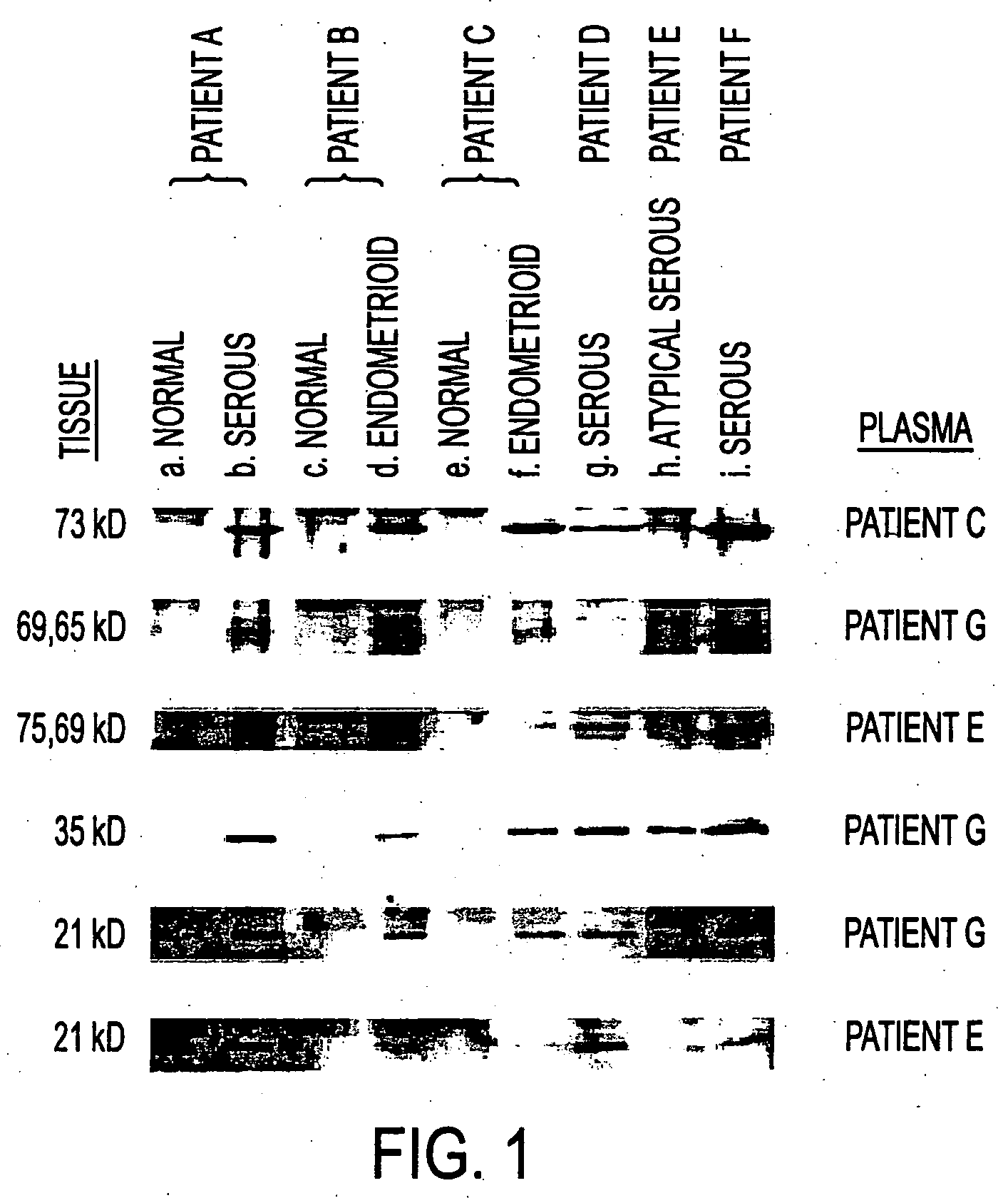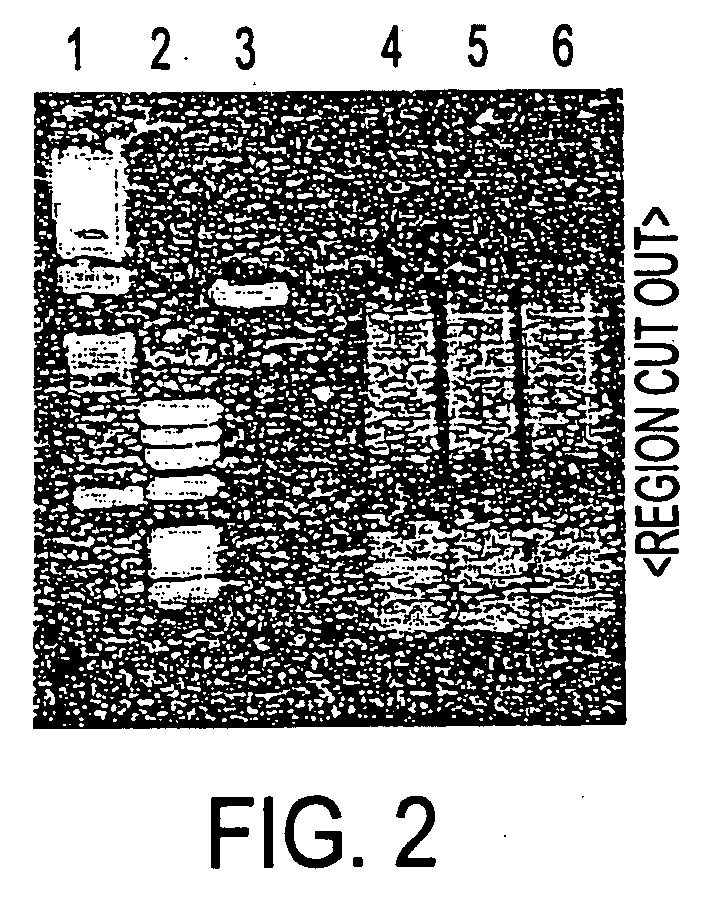Immunogenic ovarian cancer genes
a technology of ovarian cancer and genes, applied in the field of cancer diagnostics and treatments, can solve the problems of difficult, critical, and particularly difficult identification of novel serum biomarkers of ovarian cancer, and none of the various molecules detected at elevated levels in the sera of ovarian cancer patients have been established as sufficiently consistent, so as to increase the likelihood of cancer
- Summary
- Abstract
- Description
- Claims
- Application Information
AI Technical Summary
Benefits of technology
Problems solved by technology
Method used
Image
Examples
example 1
Detection of Autologous Antibody to Ovarian Cancer by Western Blot
[0100] Expression of eukaryotic cDNAs in bacteria often does not generate proteins in their native conformation. Cellular proteins subjected to SDS-PAGE and Western blot are generally denatured. Therefore those antibodies to the linear epitopes relevant for screening proteins expressed in bacteria will often be detected by Western blot.
[0101] To initiate this study, patient sera were screened for autologous antibodies to ovarian tumor antigens by Western blot. Twenty micrograms of tissue extract was loaded in each lane and equal loading confirmed by Ponceau S staining. 20 μg of protein extracted from tissue specimens including normal ovary (a,c,e), and ovarian tumors of serous (b,g,i), atypical serous (h) and endometrioid (d,f) histology were separated on a 10% SDS-PAGE gel and transferred to a PVDF membrane. After electroblotting, membranes were probed with patient sera at 1:500 and then 1:10,000 peroxidase-linked ...
example 2
cDNA Expression Library Generated from Cell Line OV1063
[0104] We have generated a cDNA expression library in XZAP bacteriophage from polyA+ mRNA purified from the cancer cell line OV1063 (Horowitz, A. T., Treves, A. J., Voss, R., Okon, E., Fuks, Z., Davidson, L., and Biran, S., “A New Human Ovarian Carcinoma Cell Line: Establishment and Analysis of Tumor-Associated Markers,”Oncology, 42: 332-337, 1985). OV1063 cells generate tumors in immunodeficient mice that have been widely used for drug therapy studies (Miyazaki, M., Schally, A. V., Nagy, A., Lamharzi, N., Halmos, G., Szepeshazi, Kr., and Armatis, P., “Targeted Cytotoxic Analog of Luteinizing Hormone-Releasing Hormone AN-207 Inhibits Growth of OV-1063 Human Epithelial Ovarian Cancers in Nude Mice,”Am. J. Obstet. Gynecol., 180: 1095-1103, 1999). A cell line rather than tumor tissue was used to reduce problems in screening caused by contaminating lymphocytes (as the secondary antibody used in screening will recognize cloned human...
example 3
Screening of Expression Library with Ovarian Cancer Patient Serum
[0105] An important issue in screening of λZAP bacteriophage expression libraries with patient serum is the elimination of non-specific antibody i.e. antibody specific for E. coli. We have eliminated this non-specific reactivity by confluent infection of E. coli lawns with wild type λZAP bacteriophage to achieve confluent lysis and subsequent transfer to nitrocellulose filters. Patient sera are diluted in blocking buffer and pre-absorbed overnight with such a filter. This procedure permits screening of the λ expression library for specifically immuno-reactive clones.
[0106] Serum from a particular patient with serous ovarian carcinoma demonstrated strong reactivity with ovarian tumors, and the OV1063 cell lysates, by Western blot. Therefore, the OV1063 cDNA expression library of 800,000 independent clones in λZAP bacteriophage was screened using this particular ovarian cancer patient serum. Expression of proteins was ...
PUM
| Property | Measurement | Unit |
|---|---|---|
| Digital information | aaaaa | aaaaa |
| Digital information | aaaaa | aaaaa |
Abstract
Description
Claims
Application Information
 Login to View More
Login to View More - R&D
- Intellectual Property
- Life Sciences
- Materials
- Tech Scout
- Unparalleled Data Quality
- Higher Quality Content
- 60% Fewer Hallucinations
Browse by: Latest US Patents, China's latest patents, Technical Efficacy Thesaurus, Application Domain, Technology Topic, Popular Technical Reports.
© 2025 PatSnap. All rights reserved.Legal|Privacy policy|Modern Slavery Act Transparency Statement|Sitemap|About US| Contact US: help@patsnap.com



